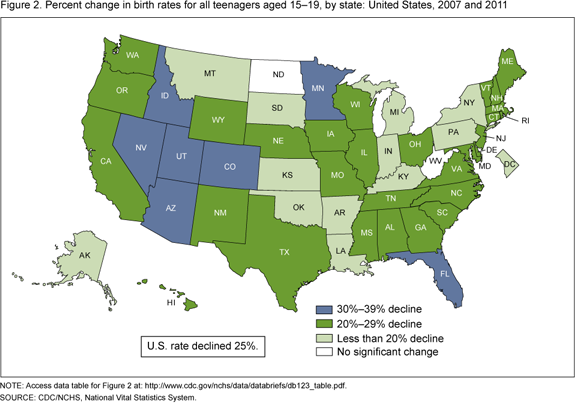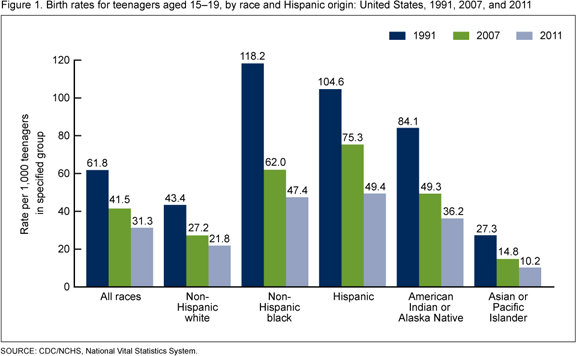June 17, 2013
Good News: Teen Birth Rates Go Down!
By: Sharon Muza, BS, LCCE, FACCE, CD/BDT(DONA), CLE | 0 Comments
Today, I highlight the recent news about the significant drop in teenaged births in the US, including some interesting trends. Then on Thursday, we will continue our "Welcoming All Families" series with "Working with Teen Parents" and take a look at childbirth classes for teenage mothers. Some ideas and suggestions for working with pregnant teens, in a specialized class designed to meet their needs or integrated within your regular childbirth class offerings. - SM

Number of babies born to US teen mothers 2011
The National Center for Health Statistics, part of the Center for Disease Control and Prevention recently released the most up to date data for teen birth rates in the United States. The good news is that teen birth rates dropped by 25% from 2007-2011. Since 1991, teen birth rates have been on a decline, with the exception of 2006-2007, but this drop has picked up steam in most recent years. In 2011, a total of 329,797 babies were born to women aged 15 - 19 years, for a live birth rate of 31.3 per 1,000 women in this age group. (Hamilton, 2012.) In 2007, the teen birth rate had been 41.5/1,000 teenagers aged 15-19. The rate dropped by 8% just between 2010 and 2011. Just two states, North Dakota and West Virginia did not experience significant changes.

http://www.cdc.gov/nchs/data/databriefs/db123_fig2.png
This is particularly good news, as babies born to teenaged mothers are more likely to be born prematurely, have low birth weights and have a higher rate of infant mortality, when compared with mothers aged 20 or older. All of these consequences carry significant financial costs for families. These consequences cost the US government 10.9 billion dollars annually.
High school drop out rates are increased amongst teen mothers, and many may not go back and receive a high school diploma or GED. This has a major financial impact for these young families for years to come. Only 50% of teenage mothers receive a diploma by the age of 22. (Perper, 2010.)
The decline in teen birth rates may be linked to economic and attitudinal factors, according to the Pew Research Center. Overall, birth rates amongst all age groups go down during rough economic times, as the United States has been experiencing since the recession began in 2007-2008. Currently, teens seem to be less sexually active and the teenagers that are choosing to have sex are more likely to use birth control then ever before. (Martinez, 2011.)
Declines in rates were steepest for Hispanic teenagers, averaging 34% for the United States, followed by declines of 24% for non-Hispanic black teenagers and 20% for non-Hispanic white teenagers. Interestingly, the difference in long-term birth rates for non-Hispanic black and Hispanic teenagers has essentially disappeared by 2010. Even though the USA has seen these large drops in teenage birth rates, the US teen birth rate is one of the highest amongst Western countries.

http://www.cdc.gov/nchs/data/databriefs/db123_fig1.png
References
DeSilver, D. (2013, May 28). What's behind the falling teen birth rates?. Retrieved from http://www.pewresearch.org/fact-tank/2013/05/28/whats-behind-the-falling-teen-birth-rates/
Hamilton BE, Mathews TJ, Ventura SJ. Declines in state teen birth rates by race and Hispanic origin. NCHS data brief, no 123. Hyattsville, MD: National Center for Health Statistics. 2013.
Martinez G, Copen CE, Abma JC. Teenagers in the United States: Sexual activity, contraceptive use, and childbearing, 2006 - 2010. National Survey of Family Growth. National Center for Health Statistics. National Vital Health Stat. 2011;23(31).
The National Campaign to Prevent Teen and Unplanned Pregnancy. Counting it up: The public costs of teen childbearing: Key data
Perper K, Peterson K, Manlove J. Diploma Attainment Among Teen Mothers. Child Trends, Fact Sheet Publication #2010-01: Washington, DC: Child Trends; 2010.
United Nations Statistics Division. Demographic yearbook 2009 - 2010 .
.
Tags
Childbirth education Maternal Infant Care Teen Pregnancy CDC Birth Rates Teen Birth Rate